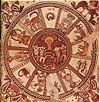- Portal:Middle East
-
- Wikipedia portals:
- Culture
- Geography
- Health
- History
- Mathematics
- Natural sciences
- People
- Philosophy
- Religion
- Society
- Technology
MIDDLE EAST PORTAL
The Middle East is a political and cultural subregion of Eurasia or of Afro-Eurasia. The core of the region comprises the lands between the Mediterranean Sea and the Persian Gulf along with the Arabian and Sinai peninsulas. Sometimes, it is used in a broader sense which can include areas stretching from North Africa in the west to Pakistan in the east and the Caucasus and/or Central Asia in the north. The media and various international organizations (such as the United Nations) usually considers the Middle East to be Southwest Asia (including Cyprus and Iran) plus all of Egypt.
Selected article
The Hebrew calendar (Hebrew: הלוח העברי) or Jewish calendar is the annual calendar used in Judaism. It determines the dates of the Jewish holidays, the appropriate Torah portions for public reading, Yahrzeits (the date to commemorate the death of a relative), and the specific daily Psalms which some customarily read. Two major forms of the calendar have been used: an observational form used prior to the destruction of the Second Temple in 70 CE, and based on witnesses observing the phase of the moon, and a rule-based form first fully described by Maimonides in 1178 CE, which was adopted over a transition period between 70 and 1178.
The "modern" form is a rule-based lunisolar calendar, akin to the Chinese calendar, measuring months defined in lunar cycles as well as years measured in solar cycles, and distinct from the purely lunar Islamic calendar and the almost entirely solar Gregorian calendar. Because of the roughly 11 day difference between twelve lunar months and one solar year, the calendar repeats in a Metonic 19-year cycle of 235 lunar months, with an extra lunar month added once every two or three years, for a total of seven times every nineteen years. As the Hebrew calendar was developed in the region east of the Mediterranean Sea, references to seasons reflect the times and climate of the Northern Hemisphere.
Selected picture

Photo credit:Saperaud This animation shows an example of Arabic calligraphy. The text translates as "Mahmud Khan son of Abdulhamid is forever victorious" and refers to a Sultan of the Ottoman Empire.
In the news
Wikinews Middle East portal- November 2: UNESCO votes in favor of Palestine membership
- October 29: No-fly zone demanded by Syrian protesters
- October 23: Crown Prince Sultan of Saudi Arabia dies
- October 16: Iran continues to lash out at film industry
- October 11: Gilad Shalit to be exchanged for Palestinian prisoners
- September 28: Saudi Arabian women gain right to vote, run in elections
- September 23: US hikers freed after two years of custody in Iran
- September 5: Proms performance by Israel Philharmonic Orchestra disrupted
- September 2: Documents regarding post-9/11 prisoner transport flights released
- August 21: Egypt recalls envoy in Israel
Did you know?
WikiProjects
Category:WikiProject Middle East
Countries of the Middle East:
Bahrain · Cyprus · Egypt · Iran · Iraq · Israel · Jordan · Kuwait · Lebanon · Oman · Palestine · Qatar · Saudi Arabia · Syria · Turkey · United Arab Emirates · YemenHistory of the Middle East:
Ancient Egypt · Ancient Near East · AssyriaReligions of the Middle East:
Christianity · Islam · Judaism · ZoroastrianismSelected history
The Sassanid Empire or Sassanian Empire (Persian: ساسانیان Sasanian) is the name used for the fourth Iranian dynasty, and the second Persian Empire (226 - 651). The Sassanid dynasty was founded by Ardashir I after defeating the last Arsacid king, Artabanus IV and ended when the last Sassanid Shahanshah (King of Kings), Yazdegerd III (632–651), lost a 14-year struggle to drive out the early Caliphate, the first of the Islamic empires. The empire's territory encompassed all of today's Iran, Iraq, Armenia, Afghanistan, eastern parts of Turkey , eastern parts of Syria, Pakistan, Caucasia, Central Asia and Arabia. During Khosrau II's rule in 590–628 Egypt, Jordan, Palestine, Lebanon was also annexed to the Empire. The Sassanids called their empire Erānshahr ايرانشهر (Iranshæhr) "Dominion of the Iranians (Aryans)"
The Sassanid era, encompassing the length of the Late Antiquity, is considered to be one of the most important and influential historical periods in Iran. In many ways the Sassanid period witnessed the highest achievement of Persian civilization, and constituted the last great Iranian Empire before the Muslim conquest and adoption of Islam. Persia influenced Roman civilisation considerably during the Sassanids times, their cultural influence extended far beyond the empire's territorial borders, reaching as far as Western Europe, Africa, China and India and played a foremost role in the formation of both European and Asiatic medieval art. This influence carried forward to the early Islamic world. The dynasty's unique and aristocratic culture transformed the Islamic conquest of Iran into a Persian Renaissance. Much of what later became known as Islamic culture, architecture, writing and other skills, were taken mainly from the Sassanid Persians into the broader Muslim world.
Things you can do
- Contribute to related articles.
- Suggest new feature articles and pictures.
Categories
Categories:- Asian portals
- Middle Eastern portals
- Middle East
- African portals
Wikimedia Foundation. 2010.


